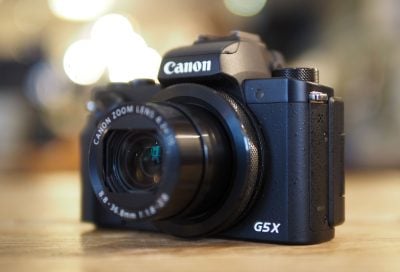Canon PowerShot G5X review
-
-
Written by Gordon Laing
In depth
The Canon PowerShot G5X is a compact DSLR-styled bridge camera with a 1in sensor, built-in viewfinder and 4.2x zoom. Announced in October 2015 alongside the slim G9X, they extend the PowerShot G series to five models. The chunky G1X Mark II officially remains the flagship model with its larger 1.5in sensor and 5x / 24-120mm zoom, but for many photographers, the G5X will be the preferred choice.
The PowerShot G5X becomes the first in the current lineup with a built-in electronic viewfinder. It’s a good one too with a large magnification, 2.36 Million dot OLED panel, proximity sensor and shooting information that turns as you compose in the portrait / tall orientation – a great feature I’ve only seen Fujifilm implement before. There’s also a fully-articulated side-hinged touchscreen, which provides much more flexibility than a screen that only tilts.
The 4.2x / 24-100mm optical range (with a 5cm closest focusing distance) may be inherited from the G7X (and its successor the Mark II) and out-gunned by many, but remains bright at f1.8-2.8, and the customizable lens control ring feels nicely damped with positive clicks. Rounding-off the specifications are built-in Wifi with Dynamic NFC, Full HD video at up to 1080 / 60p, USB charging in-camera, and an unusual finger wheel that’s vertically-mounted and flat to the front surface. It all makes the G5X one of the most powerful 1in compacts to date but is it right for you? In my full review I’ll detail all the features and compare it against Sony’s RX100 III, the Lumix TZ100 / ZS100 and Canon’s other G models to help you make the right choice!
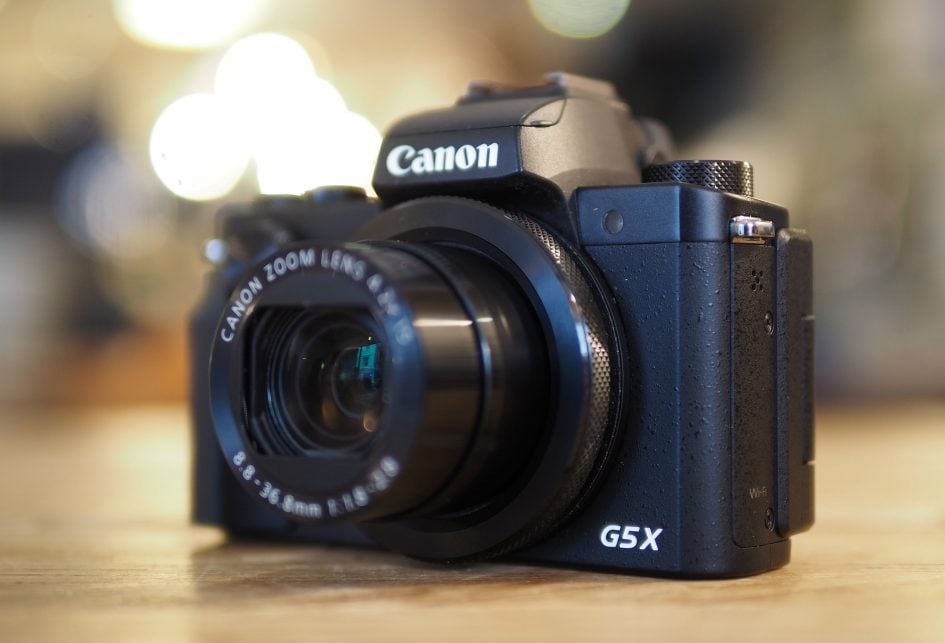
Canon PowerShot G5X design and controls
Styled like a mini-DSLR, the PowerShot G5X is an attractive-looking camera that’s designed to appeal to enthusiasts. The easiest way to think of it is as the sensor and lens of the PowerShot G7X, but repackaged in a chunkier body with a fully-articulated screen, electronic viewfinder and more controls.
Measuring 112x76x44.2mm and weighing 377g with battery, it’s understandably larger in every dimension than the G7X, but sufficiently small to retain the charm of other 1in sensor models. To put it in perspective, the G7X measures 103x60x40.4mm and weighs 304g with battery, while Sony’s RX100 Mark III – arguably its major rival – measures 102x58x41mm and weighs 290g with battery. Panasonic’s Lumix TZ100 / ZS100 is another key rival, squeezing-in the same 1in sensor and a decent viewfinder but with a 10x optical zoom and 4k video into a body measuring 111x65x44.3mm and weighing 310g with battery.
The G7X, RX100 III and TZ100 / ZS100 may all be chunky compacts, but they’ll just about squeeze into most trouser pockets, whereas the protruding viewfinder head of the G5X means it’s more at home in a coat pocket or small bag – indeed it’s beginning to approach the size of the smallest Micro Four Thirds cameras when fitted with a pancake lens. Design-wise I was reminded more than once of the Olympus OMD EM5 Mark II with its compact body, viewfinder hump and fully-articulated touch-screen. Of course that’s a different class of camera in terms of build, lens flexibility and price, but the bottom line is the G5X is the largest of its immediate peer group.
The flip-side is the PowerShot G5X becomes the most comfortable of its peer group to hold and operate. The chunkier body accommodates a decent grip on the front and a generous thumb rest on the rear, allowing you to hold the camera very securely. And while its main rivals also enjoy the additional stability of composing with their viewfinders to your eye, only the G5X lets you flip its screen out to the side and cup it in the palm of your left hand, providing even greater support. In short, it was easy to hold the G5X very steadily, allowing me to capture stills and smooth video in situations where other cameras would suffer from more wobbles.

Most of the 1in class compacts offer plenty of manual controls, but the G5X goes above and beyond with no fewer than three control dials. Like the G7X before it, there’s a ring around the lens barrel and a thumb wheel on the rear, but these are now joined by a finger dial mounted vertically on the front surface. This looks unusual at first, but really it’s no different in operation to finger dials which are embedded within grips revealing only their tips above the surface – the only difference here is the entire dial is exposed. In use it feels very natural, effectively being positioned further forward than an embedded one within the narrow body would have allowed – indeed I found its size and clickable feedback were preferable to the rear thumb wheel and the newly-damped lens ring.
It’s possible to customise the function of all three dials from a choice of eight settings or disable them if preferred, and you can assign different functions depending on if you’re in Program, Manual, Aperture or Shutter Priority or in Manual Movie mode; the settings in the Auto modes are fixed to defaults. It’s also possible to customise the function of the AF area and Movie record buttons to 23 or 24 different settings, and to choose whether the Shutter release locks both the focus and exposure or just the focus, leaving exposure lock to the separate star button.
Even in the absence of additional dedicated function buttons, the triplet of custom dials and a separate one dedicated to exposure compensation means it’s possible to operate the G5X pretty much any way you like, leaving the function of the AF area and movie buttons for further fine-tuning if absolutely necessary. For everything else, Canon’s on-screen Q Menu provides quick access with the touch interface. My only complaint regards the movie record button which I managed to press accidentally on numerous occasions when picking the camera up despite being indented within the thumb rest – maybe that’s just me though.
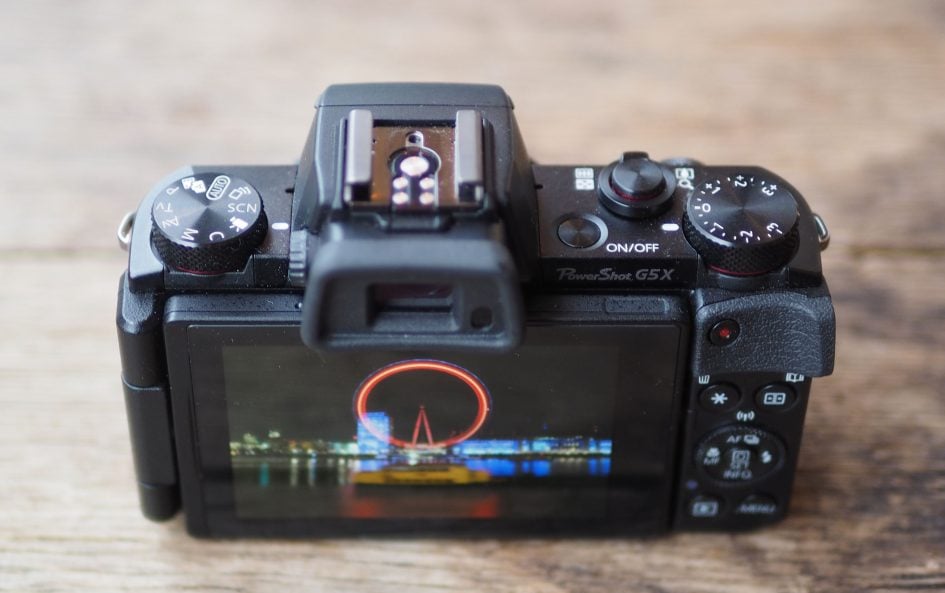
Composition is the highlight of the G5X, being the only model in the current G-series lineup to feature a side-hinged fully-articulated screen and a built-in viewfinder. Having both make it the preferred model in use, especially as Canon’s not skimped on the specification of either. So the screen is a 3in / 1040k dot touch panel, while the viewfinder is a 0.39 type OLED with 2.36 Million dots and respectable magnification. I’m pleased to see the inclusion of an eye sensor to switch between them, and also that the shooting information turns to remain upright in the viewfinder when composing in the portrait format – something I’ve only seen on high-end mirrorless cameras like Fujifilm’s XT1 and XT10, although like those models the information on the screen doesn’t rotate. If preferred you can disable the information rotation on the G5X.
The side-hinged screen provides great flexibility as you can comfortably compose at high or low angles whether you’re shooting in the landscape / horizontal or portrait / vertical orientation; as someone who shoots often in the portrait shape, I really appreciate this capability over screens that only tilt vertically. It also means the screen can simply flip out to the side to face the subject for self-portraits or filming pieces to camera, rather than having to clear the top of the camera when tilting vertically, and of course you can also flip the screen back shut on itself for protection. As noted earlier, flipping the display out to the side also lets you rest the screen in the palm of your left hand for even greater stability.
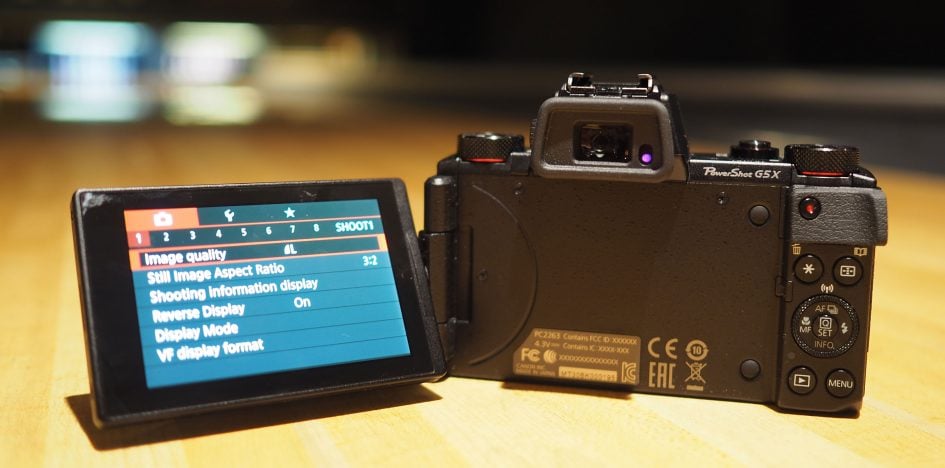
All of Canon’s PowerShot G models feature touch-screens, and they’re a key advantage over Sony’s RX100 series. Some photographers claim not to like them, but who wouldn’t want the ability to reposition an AF area with a single tap? Canon’s user interface also responds well to touch, but if you continue to be touch-phobic, you can always turn the feature off.
Yes I do love the screen on the G5X, but the viewfinder is also a wonderful thing to have, and invariably became my natural choice when shooting with the camera. Having it always available atop the body may make the camera less pocketable than the RX100 III, but it also makes it a lot faster to access: all you do is bring the G5X to your eye and the viewfinder kicks-into action, whereas on the RX100 III you’ll first need to pop it up, then manually pull it out in a two-step process that is slightly clumsy and much slower. I found it made the G5X a quicker and more responsive camera, beneficial to spontaneous situations, although again it makes the body less pocketable than the Sony. Panasonic’s Lumix TZ100 / ZS100 also enjoys the benefit of a viewfinder that’s always available, although it lacks any screen articulation. So for me the Canon G5X becomes the best-equipped 1in camera for composition.
Pressing the INFO button cycles through three pages of information and overlays, the first two being customizable and the last one offering a clean view. On the custom views you can choose from any combination of shooting details, a dual-axis leveling gauge, histogram and one of two alignment grids, and it’s possible to configure the viewfinder and screen preferences separately.
Pressing the Q button in the middle of the rear thumb wheel fires-up Canon’s familiar quick menu which superimposes rows of icons on the left and right sides for access to common settings. These vary depending on mode, but in PASM you’ll have quick access to the AF area, photo quality, video quality, self-timer, ND filter, metering, sensitivity and white balance. It’s easy to tap your way through these or indeed the entire paged menu system using the screen, or with the rocker wheel if preferred. You can also customize which options appear in the Q menu, for example adding aspect ratio and removing any of the above to minimize clutter.
The viewfinder head is also home to a popup flash that’s raised by hand. It’s fairly small, but sufficient for close-range illumination and adjustable by three levels if desired with front or rear curtain sync options. Meanwhile if you want more flash power, the G5X can accommodate any of Canon’s Speedlight flashguns on its hotshoe, a rarity on most 1in compacts and another selling point for Canon here.
Behind a flap on the right side of the body you’ll find a Micro USB port, HDMI Micro connector and a port for the optional RS-60E3 remote cable; there’s also built-in Wifi with NFC that I’ll cover in detail later in the review and you can of course use the Wifi to operate the camera by remote control.
The NB-13L Lithium Ion battery and SD card are housed in a compartment underneath the camera, while the tripod thread is slightly off-centre from the optical axis of the lens. Canon quotes the battery as being good for around 210 shots. For video, I managed to film three 1080 / 25p clips lasting 24 minutes and 22 seconds each with a full charge before the battery was fully depleted; the 24 minute clip length was limited by the file reaching 3.99GB in size.
Canon supplies the camera with an external AC charger, but like the G9X launched alongside it, the G5X’s battery can also be charged in-camera over a USB connection.
I find internal charging over USB so much more convenient as it allows me to top-up a depleted battery while I’m out and about, whether using a USB port on my laptop, a portable USB battery, or a port on a vehicle. I don’t need to remember my charger nor find an AC outlet to sit next to. While photographing London one day with the G5X, I noticed the battery had become almost depleted, so connected it to an Anker portable USB battery in my bag when travelling between locations; upon arriving about half an hour later the battery was almost half-full again, allowing me to continue shooting.
Now to be fair, this is an area where Canon is playing catch-up as Sony’s been offering in-camera charging over USB for a long time. Indeed on its latest models, including the RX100 IV, you can even shoot with the camera while it’s being powered externally, whereas on the G5X the camera stops charging if you start shooting with it. But I’m still delighted that Canon’s now offering USB charging on more models and unlike Sony it also currently includes an external AC charging unit as standard for those who prefer a traditional route.
Canon PowerShot G5X lens
Canon has equipped the PowerShot G5X with exactly the same lens as the original G7X. So the G5X inherits a 4.2x optical zoom equivalent to 24-100mm with an aperture of f1.8-2.8 and a closest focusing distance of 5cm at 24mm and 40cm at 100mm. It’s a good solid specification that delivers a useful general-purpose range with decent macro capabilities and the chance to deliver a shallow depth of field under the right conditions. I’ll look closely at each in turn in practice, comparing the G5X to its big rival, the Sony RX100 III and in some cases also the earlier Mark II version of the Sony. I’ll look into the impact of the aperture in a moment, but first, what does the G5X coverage give you in practice? Here’s shots taken from the same position comparing its widest and longest focal lengths.

Above: Canon G5X coverage, left at 24mm equivalent, right at 100mm equivalent
Looking at the competition, Sony has equipped its RX100 III with a 2.9x optical zoom delivering an equivalent range of 24-70mm with a bright focal ratio of f1.8-2.8. When the lens is set wide at 24mm, the closest focusing distance is the same 5cm as the Canon, although at the 70mm end the Sony can focus at 30cm compared to 40cm for the G7X, albeit the Canon doing so at 100mm. So the Canon and Sony RX100 III share the same 24mm wide-angle coverage, but the Canon zooms-in almost 50% further for more useful telephoto coverage.
If you want longer telephoto reach though, the Lumix TZ100 / ZS100 becomes the new leader in the pocketable 1in market with a 25-250mm equivalent range, f2.8-5.9 focal ratio, and a closest focusing distance of 5cm when wide and 70cm at the long-end. So the Lumix TZ100 / ZS100 and G5X start at roughly the same wide coverage, but the Lumix zooms two and a half times further at the long-end, giving it considerably greater reach. The compromise is the focal ratio, with the G5X and RX100 III being over a stop brighter at the wide-end, and advantage that continues throughout their ranges. This allows the Canon and Sony to deploy sensitivities one stop lower or shutter speeds twice as fast under the same conditions, and also achieve slightly shallower depth of field effects – although it’s important to remember that if you’re able to exploit the longer zoom on the Lumix, you’ll achieve greater blurring in the background than either the Canon or Sony.
So what sort of blurring can you expect in practice? To find out I photographed a portrait at the maximum focal length and aperture for the G5X and RX100 III, adjusting my position to maintain approximately the same subject framing; the Lumix wasn’t available at the time of this comparison.
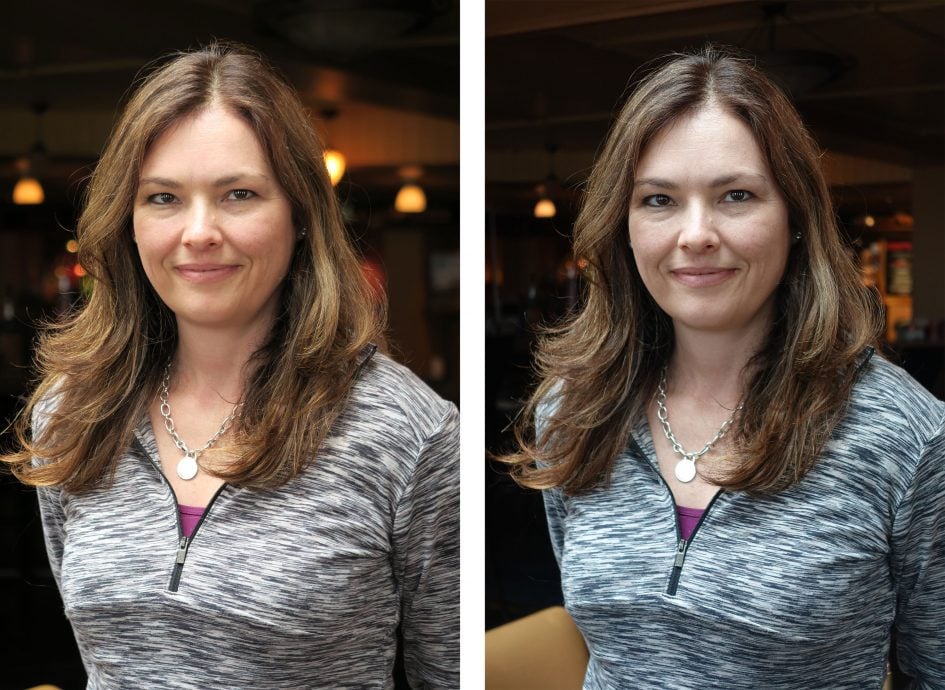
Above left: Canon G5X at 100mm f2.8, above right: Sony RX100 III at 70mm f2.8
The longer focal length of the G5X has made the background elements bigger on the frame, including of course the defocused ones. So the blurring effect looks greater on the G5X above left, than the RX100 III.
To really maximize the shallow depth of field effect you should get as close as possible to your subject, so I made a second comparison, again at their longest focal lengths and maximum apertures, but this time also including the older Sony RX100 II. The RX100 II shares the same 100mm maximum focal length as the G5X, but with a much slower f4.9 aperture.

Above left: Sony RX100 II at 100mm f4.9, middle: Sony RX100 III at 70mm f2.8, right: Canon G5X at 100mm f2.8
As you can clearly see above, the Canon G5X is delivering the greatest blurring of the three, followed by the Sony RX100 III and then the RX100 II, confirming that what you really want to maximize this effect is a longer focal length and a brighter aperture.
While shooting this composition though, I was very aware of each camera’s minimum focusing distance when zoomed to telephoto. As mentioned earlier, the G5X can focus to 40cm at 100mm and the RX100 III can get as close as 30cm at 70mm. But the older RX100 II can only focus down to 55cm at 100mm. This forced me to shoot the composition above from 55cm, showing a best-case scenario for the RX100 II, but the G5X, RX100 III and Lumix TZ100 / ZS100 can all focus closer, delivering greater blurring effects. Here’s two shots from the G5X at or close to its minimum focusing distance when zoomed-out to 24mm and in-to 100mm. Both were taken with the camera’s maximum aperture of f1.8 and f2.8. respectively.

Above: Canon G5X macro at 24mm f1.8

Above: Canon G5X macro at 100mm f2.8
It’s also worth looking at whereabouts in the focal range the aperture changes, as some lenses slow down faster than others. The Canon G5X starts at f1.8 at 24mm then slows to f2 at 28mm, f2.2 at 35mm, f2.5 at 39mm, then reaches its minimum aperture of f2.8 at 55mm and stays with it all the way up to 100mm.
On the Sony RX100 III, the f1.8 aperture is only available at 24mm, slowing to f2 at 25mm and f2.5 at 28mm. Then at 32mm the lens slows to f2.8 and stays there for the rest of the range up to 70mm. The older RX100 II starts at f1.8 at 28mm, hits f2 at 30mm, then f2.8 at 35mm, f4 at 66mm and the minimum f4.9 between 97mm and 100mm.
So the Canon G5X actually stays slightly brighter than the Sony until they’re mid-way through their ranges. For example at 28mm or 35mm, the G5X enjoys two thirds of a stop advantage over the RX100 III, in turn allowing it to deploy lower ISOs under the same conditions. It’s revealing to note the Mark III actually slows down by one whole stop by the time it reaches 28mm, whereas the G5X doesn’t lose a whole stop until it’s at 39mm.
Canon has usefully equipped the G5X with a built-in Neutral Density (ND) filter which reduces the amount of light by three stops. This is particularly useful for using larger apertures in bright conditions or for deploying longer exposures in dim conditions to better blur the motion of water or clouds. In a nice upgrade over the original G7X, the ND filter can now be set to enable automatically, which means you never need to worry about bumping-up against the fastest shutter speeds in bright conditions; previously on the G7X you needed to set the ND filter manually, although this option is also still available on the G5X.
To see what’s possible with the ND filter enabled, I took this shot of The London Eye which, with the aperture closed to f11 and the sensitivity set to the lowest 125 ISO, resulted in a two minute exposure. I used Bulb mode for the long exposure, triggering the process over Wifi using the Camera Connect app on my Galaxy S6, although I did have to keep the virtual shutter release button pressed throughout. Enabling the ND filter allowed me to extend the exposure from 15 seconds to 120 seconds, which even with the slow rotation of the wheel provided the desired trailing of the pod lights and some blurring on the River Thames below.
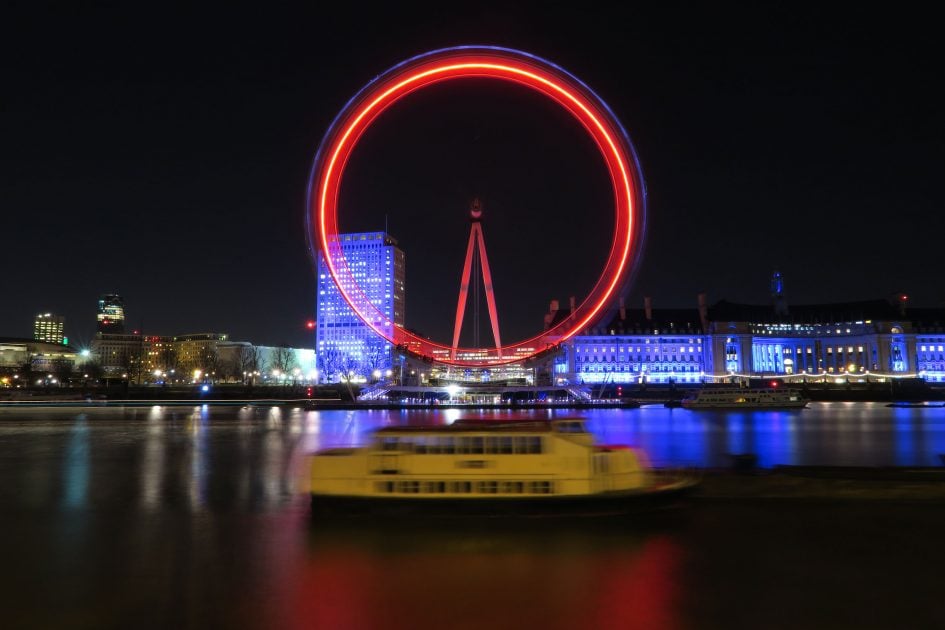
Above: Canon PowerShot G5X long exposure with ND filter: 120 seconds
Finally, the G5X lens offers optical stabilisation which Canon reckons is good for three stops. To put it to the test I took a series of shots at the longest 100mm focal length using steadily decreasing shutter speeds, first without stabilisation enabled, then with it active.

Above: Canon G5X stabilisation. Left: Off, right: enabled. Both at 100mm and 1/25
On the conditions of the day, I needed a shutter speed of just over 1/100 to handhold a shot at 100mm without stabilisation. With stabilisation enabled, I achieved the same result at 1/25, corresponding to just over two stops of compensation. Note these tests were using the screen, but greater stability can be achieved when framing with the viewfinder when the camera’s held to your face. This is a key benefit of cameras with built-in viewfinders over those without.
The stabilisation is also very effective when filming handheld video, even when walking around with the camera. Here’s a video I filmed in London’s Borough Market – a great place for lunch – where the additional Auto Level feature has ensured the footage is steady and straight.
Above: Download the original file (Registered members of Vimeo only). Sample movie filmed with the Canon PowerShot G5X, demonstrating its stabilisation when walking. I filmed this with the lens wide and the screen flipped-out and rested in my left palm for stability.
Canon PowerShot G5X focus and continuous shooting
The G5X, like most compacts, relies on a contrast-based AF system which hunts back and forth before confirming focus. In terms of focus areas, the PowerShot G5X offers the usual two options for a Canon compact: 1-point and Face / Tracking. The former, as its name suggests, uses a single AF area which can be repositioned anywhere on the screen with a simple tap on the desired part. This is, for me, a major advantage over the RX100 III which doesn’t have a touch-screen. You can also change the size of the single AF frame.
Switch to Face / Tracking and the G5X will attempt to recognize a human face in the composition. If it can’t, it falls immediately back to a multi-area system. The Face ID option also allows you to register up to 12 different people by storing images of their faces, after which the camera will name and prioritise them if they’re spotted on the frame.
You can also choose between One Shot for single autofocus or Servo for continuous autofocus, although perhaps counter-intuitively if you want to keep focusing during a burst, Canon recommends coupling Servo with 1-Point AF rather than the tracking option. There’s also a Continuous AF option in the menus, but this refers to pre-focusing where the G5X makes adjustments as you compose, before you’ve even pressed the shutter release to accelerate the final process.
In One Shot mode, the G5X snaps-into focus fairly swiftly, certainly as fast as the higher-end Sony RX100 IV. If you have Continuous AF enabled for pre-focusing, the G5X normally locks-onto the subject regardless of focal length in less than a second with minimal hunting.
As I mentioned earlier, the joy of the touch-screen is being able to reposition a single AF area with a simple tap – something that’s still lacking even on the RX100 IV. If you prefer the automatic life though, the Face / Tracking option works well.
It’s also possible to switch the G5X into manual focus and use the up and down buttons or touch-screen controls to adjust the distance using an on-screen scale and optional focus peaking. Unlike the G7X before it, you can also now adjust the focus manually while filming video, again using the same control system. I’ll discuss movie autofocus in the movie section later in the review.
In terms of continuous shooting, the G5X is quoted as being able to fire bursts at 5.9fps or 4.4fps with AF. To put it to the test I fitted a freshly-formatted UHS card, set the sensitivity to 400 ISO and the shutter speed to 1/500 and timed a series of bursts. With the quality set to Large Fine JPEG, I fired-off 73 frames in 11.7 seconds for an average speed of 6.2fps – and the camera seemed happy to keep shooting. The average speed was faster than quoted and the initial few frames were a little faster still. Switching the camera to RAW though saw the speed plummet to just less than one frame per second, effectively ruling it out for action photography in anything other than JPEG.
The results above were with the camera’s AF system set to Single and locking the focus on the first frame. If you set the focus to Servo, the G5X will attempt to refocus as it fires, but at a reduced speed. I managed 49 JPEGs in 10.87 seconds for a speed of 4.5fps – pretty much as quoted – and I’m pleased to report the vast majority of the frames were in focus too.
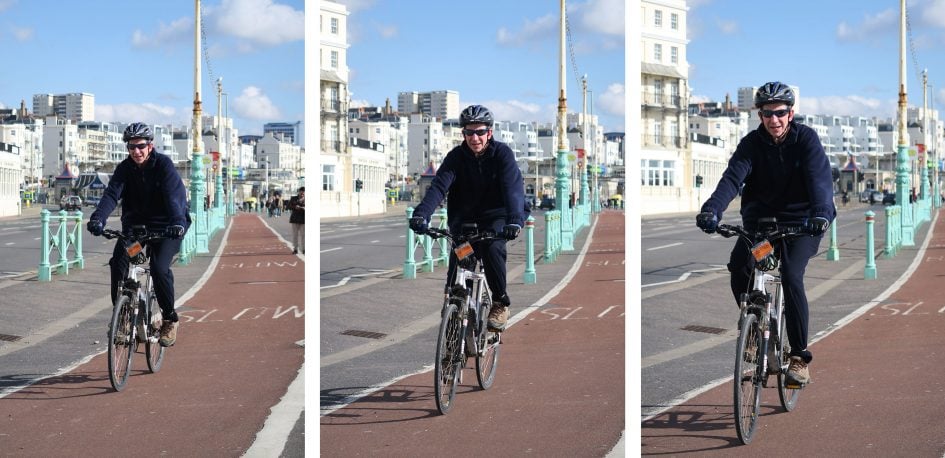
I tried the G5X’s Servo AF on a variety of subjects including approaching cyclists and vehicles, and found so long as the subject was large enough for the camera to lock-onto, it did a pretty good job at tracking it and keeping it in focus – albeit at the reduced speed of around 4.5fps.
Canon PowerShot G5X shooting modes
The PowerShot G5X’s mode dial offers full AUTO, Canon’s Hybrid AUTO, Creative Shot, Scene, a dedicated Movie position, a Custom bank, along with Program, Aperture and Shutter Priority and full Manual.
Shutter Priority and Manual offer access to the full exposure range of 1/2000 to 30 seconds, to which Manual adds a Bulb option that supports exposures up to four minutes and 16 seconds while the shutter is held; if the Touch Shutter is enabled, you can also start and end a Bulb exposure with taps on the touch-screen, but obviously you’ll need to be gentle to avoid wobbling it. Alternatively you can trigger a Bulb exposure via the smartphone app. Auto exposure bracketing is available for three stops in a range up to +/-2EV.
Set the G5X to AUTO and it’ll work out everything for you using scene detection which even accommodates and adjusts for subjects which are close, in motion, backlit, in shadow, smiling or even sleeping, including additional scenes for smiling or sleeping babies. It’s fun to point the camera at different subjects and see the scene icon adjust itself
Set the camera to Hybrid AUTO and it’ll exploit Canon’s Movie Digest feature to capture two to four seconds of video prior to you taking each photo. These are then compiled as the day goes on into a single movie which can give a fun behind-the-scenes. The idea is you normally spend at least a couple of seconds setting up a composition before taking photos and this is when people in portraits can often be most relaxed before their stock pose. When it works well, the compiled movies can certainly be fun, but at other times you may grab uncomfortable or messy footage, plus there’s the constant buffering taking place which will drain your battery sooner rather than later.
Next on the mode dial is Creative Shot which analyses the scene and grabs six shots with different effects, crops or rotations applied. Unlike the G5X, you can now choose for the six shots to be based on a certain style: Retro, Monochrome, Special or Natural, or you could go for the Auto which generates a selection. In practice it can work quite well and it’s almost like handing your camera to someone else to take a photo of a familiar subject as you’ll almost certainly end up with some views you hadn’t expected. Here’s what the G5X made of my standard test scene on Brighton beach in Auto Creative Shot.
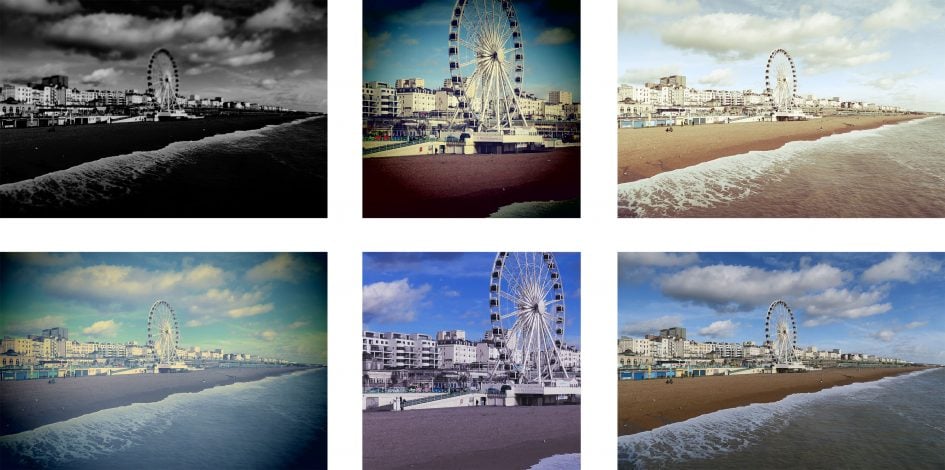
Above: Canon PowerShot G5X Creative Shot composite (Auto)
Set the G5X to the SCN mode on its dial and you’ll find a selection of effects mixed in with a handful of scene presets. Effects include HDR, Nostalgic, Fish-eye, Miniature, Toy Camera, Background Defocus, Soft Focus, Monochrome, Super Vivid or Poster, and these join Portrait, Star, Handheld Nightscene and Fireworks.
Turning the lens ring lets you adjust the intensity for most of them or settings for others. For example, in monochrome mode the ring lets you switch to sepia or blue and white effects, while in HDR mode you can choose the severity (or tastefulness) of the processing. Meanwhile the Miniature mode exploits the lens ring, touchscreen and Info buttons to adjust the position and thickness of the plane of focus along with the speed of playback if you end up choosing to film a movie. Like most Canon cameras, there’s a minor gotcha when filming Miniature movies though – if you want a widescreen HD video, you’ll need to first set the photo aspect ratio to 16:9. Here’s an example of a miniature movie below, followed by several examples of the other Creative Filters in action on still photos.
Above: Download the original file (Registered members of Vimeo only). Sample movie filmed with the Canon PowerShot G5X in its Miniature mode. As is often the case with Canon cameras, I had to set the photo shape to 16:9 in order to capture the Miniature effect in HD.

Above left: Nostalgic effect, above right: Fisheye effect

Above left: Super Vivid effect, above right: Poster effect

Above left: Toy Camera effect, above right: Monochrome effect
The HDR mode takes three exposures and combines them into one to extend the tonal dynamic range of the composition, generally revealing details otherwise lost in dark shadows or bright highlights. You can’t choose the ISO sensitivity, the bracketing depth or the exposure increment between the frames, but you can choose from five different processing effects: Natural, Art Standard, Art Vivid, Art Bold and Art Embossed. The natural option is fairly sympathetic, generally boosting detail in dark shadow and mid shadow tones. The other options deliver a far more stylised effect that may be right up your street, or may alternatively drive you onto another street entirely. Here’s an example showing Program mode below left and Natural HDR on the right.
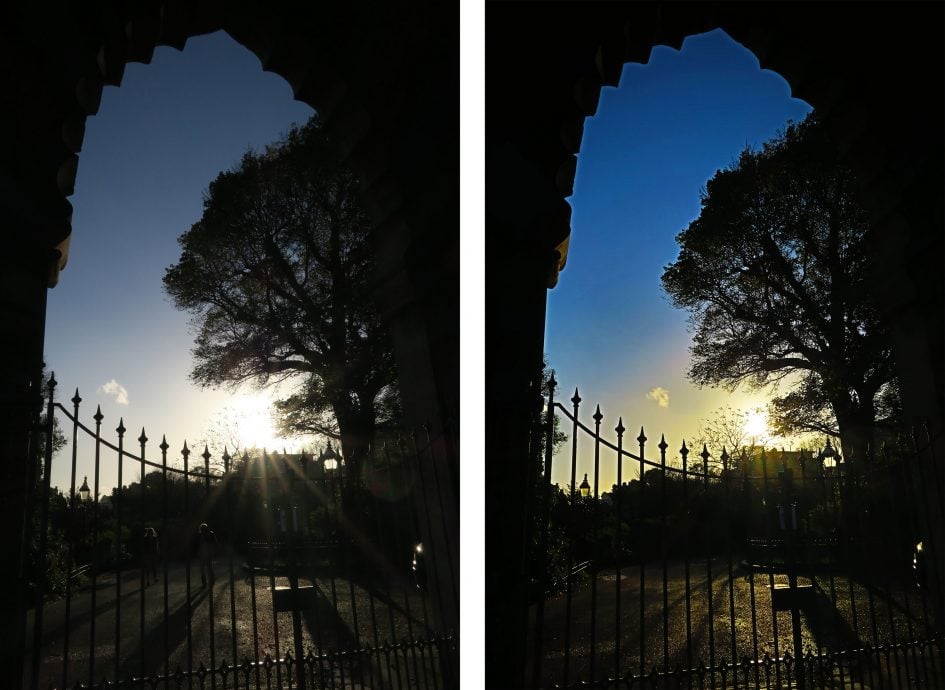
Above left: single frame (HDR off), above right: three-frame HDR (Natural preset)
The G5X also inherits four Star modes for easy astrophotography. First is Star Portrait, which composites three images taken in succession: the first fires the flash to capture the foreground person, while the second and third deploy longer exposures and high ISOs without the flash in an attempt to record the background. Once the process is complete the self-timer lamp blinks three times. The second option, Star Nightscape, is for capturing wide star fields and typically shoots a 15 second exposure at 800 ISO f1.8, which should be sufficient for basic Milky-Way type compositions.
The third mode, Star Trails, takes a series of images over a period of ten minutes to two hours before then assembling them into one image – this allows you to record the effect of star trails without the battery drain of a very long single exposure. Here’s an example I shot from my backyard in Brighton with a recording period of about 100 minutes. It’s a lot more forgiving on light pollution than the second mode and unless you have very dark skies, this is the option I’d go for when shooting stars with the G5X.

Above: Canon PowerShot G5X Star Trail mode
Finally the fourth option lets you record Star time-lapse movies, taking photos at intervals before assembling them in-camera into an accelerated video clip. Canon lets you choose 15, 30 or 60 second intervals, and a subsequent playback frame rate of 15 or 30fps. Here’s an example I filmed with the earlier G9X, set to record for two hours with a 30 second interval and medium tail effect with the final movie being encoded at 12.5fps; towards the end of the capture period the cloud rolled-in, so I stopped the process a little early after around 100 minutes.
Above: Download the original file (Registered members of Vimeo only). Sample movie filmed with the Canon PowerShot G9X in its Star Timelapse mode. I set the G9X to record for two hours with a 30 second interval and medium tail effect with the final movie being encoded at 12.5fps; towards the end of the capture period the cloud rolled-in, so I stopped the process a little early after around 100 minutes.
Astro-photography can be very technical, but these modes make it very easy to capture good results and are well worth trying if you find yourself under clear (and ideally dark) skies.
What you still won’t find on the PowerShot G5X though is a panorama mode which automatically stitches images taken in a simple sweep of the camera. Why this continues to elude Canon is beyond me, and it’s disappointing not to have it on any of their cameras. Auto panoramas are now standard on Sony and Panasonic cameras, not to mention most phones and other camera brands. They’re a sore absence on the G5X, not to mention every other Canon camera at the time of writing, and I think most owners would prefer to have this in place before indulging in the more specialist star modes.
Canon PowerShot G5X Wifi
The Canon PowerShot G5X is equipped with Wifi and NFC for wireless transfer of images between devices, GPS tagging, uploading to services and smartphone remote control. In this respect it sounds similar to earlier implementations not to mention other brands, but Canon’s made a number of improvements.
Canon now offers just one smartphone app for all its cameras: Camera Connect is available for iOS and Android devices, and I tested it on my Samsung Galaxy S6. The first thing you’ll need to do is download the app and if – like me – you have an NFC-equipped handset, you need only hold the camera and phone together for a couple of seconds to trigger the process.
In an upgrade over previous models, the G5X is also now equipped with Dynamic NFC which means you don’t even need the camera to be powered-on for it to initiate communications with an NFC phone – all you do is hold them together to trigger the download of the app and, once installed, bringing the two devices together will automatically start and connect their Wifi networks then fire-up the app – all ready for action without further interaction. If you’re in playback on the camera, you can touch the devices and again they’ll connect automatically before then asking you to select images on the camera for immediate transfer to your phone. These processes are much simpler than before where you had to manually start Wifi then connect the devices before the app would offer any control or transfer. While Sony’s NFC implementation is arguably even more direct with zero button-presses to send a photo on-screen, I have no complaints with Canon’s latest approach. And as before if your phone doesn’t have NFC, you can initiate the process using the smartphone button on the side of the camera.
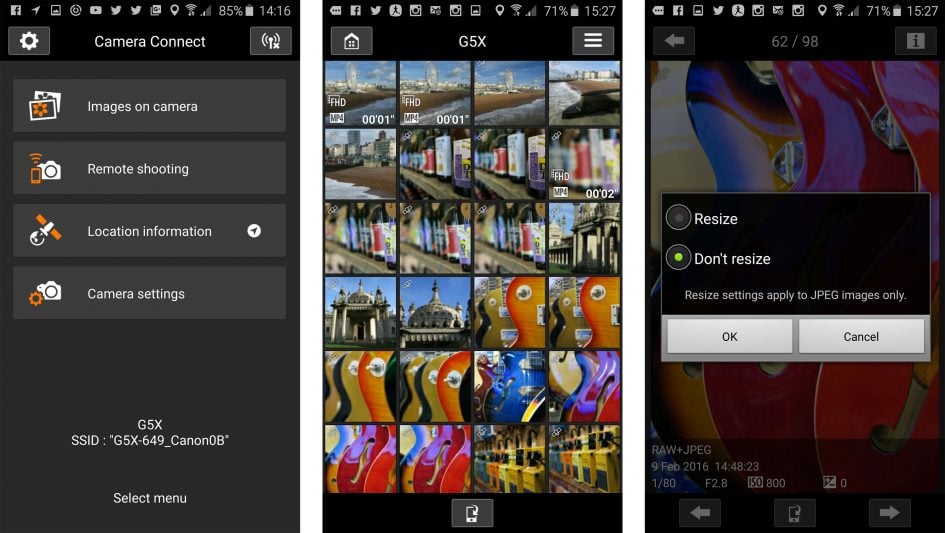
Once connected, the Camera Connect app offers four main options: Images on Camera, Remote Shooting, Location Information and Camera Settings, although the latter wasn’t supported for the G5X. Clicking Images on Camera presents a page of thumbnails to scroll through or select for further information and subsequent transfer to your phone; when transferring images you can choose to resize it to 3 Megapixels or go for the original 20 Megapixel file. RAW files aren’t visible for transfer, but movies are, although the app will first convert 1080p footage to 720p whether you like it or not. At least you can get video from the camera onto your phone though, unlike many apps.
Choosing Remote Shooting fires-up a live view from the camera with the chance to tap to refocus anywhere on the composition. There’s also a slider to operate the optical zoom remotely if desired.
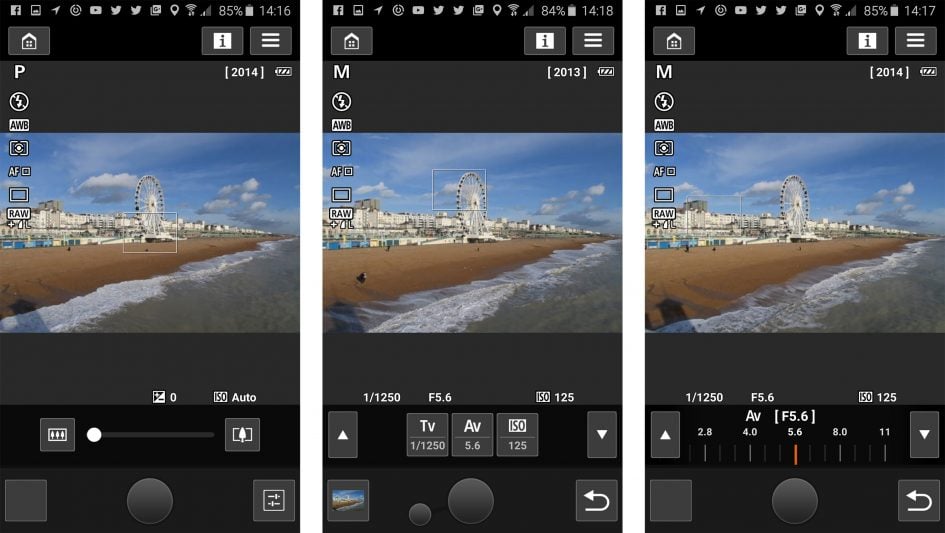
On the previous Camera Window app on the G7X, that’s as far as remote control went, with no chance to adjust the exposure. In contrast, the newer Camera Connect app offers manual control over the aperture, shutter, sensitivity and compensation, depending on the position of the exposure mode dial on the camera. For the maximum control, turn the dial to Manual, although even in the auto and semi-auto modes you’ll still have remote control over the ISO and exposure compensation. You still can’t trigger a movie recording from the app, nor change the camera’s exposure mode remotely, but it’s quick enough to exit Remote Shooting, turn the dial and enter Remote Shooting again without having to disconnect or leave the app.
The third option is Location Information which simply lets you start recording a log using your smartphone’s built-in GPS, then send location information to the camera over Wifi to tag relevant images. Here’s one I took near to Tower Bridge in London where the location is accurate – or at least as accurate as the phone supplies.
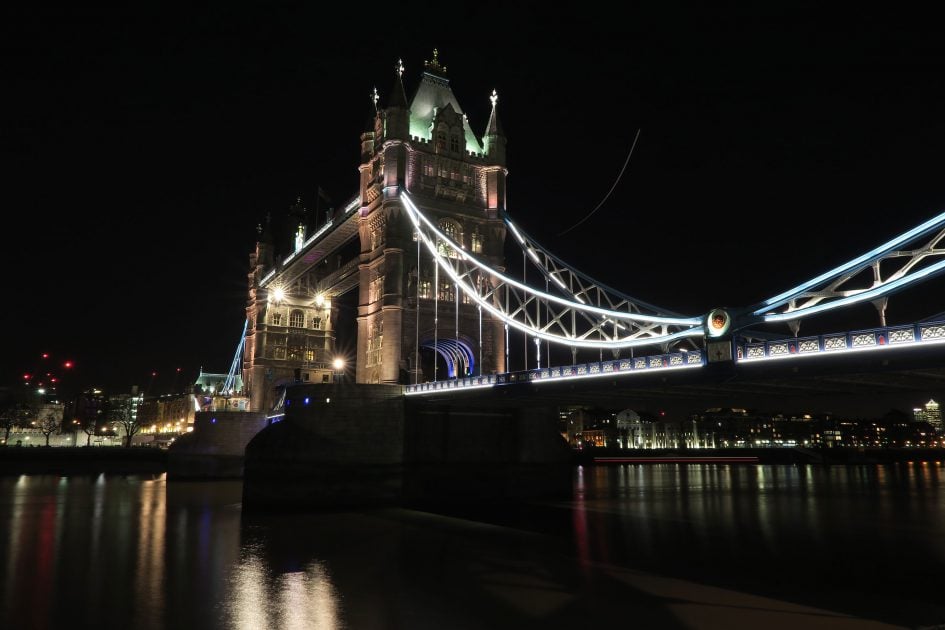
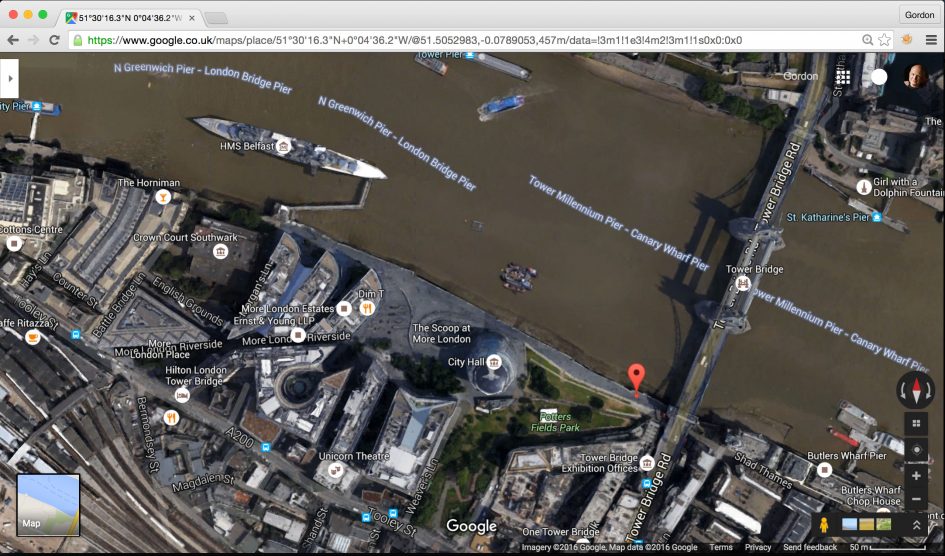
So by improving its NFC implementation, Canon’s made the connection process much quicker and easier with the G5X, while the latest Camera Connect app now offers full manual control over exposure. There’s minor annoyances like not being able to initiate a movie recording or change the shooting mode remotely, but otherwise the Canon Wifi experience is now up there with the best of its rivals.
Canon also supports the wireless transfer of images to Mac or Windows systems if the camera and computers are connected to a mutual wireless network. You can alternatively connect to wireless printers or even send images direct from the camera to sharing services albeit via Canon’s Image Gateway service. Personally I find the online sharing and captioning process much easier on a phone, so I mostly copy images between the camera and phone before letting the latter manage the final upload and sharing.
Canon PowerShot G5X movie mode
The PowerShot G5X can record Full HD video with stereo sound captured by the built-in microphones, and you can optically zoom the lens while filming. You can start recording in any mode by simply pushing the red record button on the rear, but by first turning the mode dial to Movie, the camera unlocks advanced options.
For example when the G5X mode dial is set to Movie you can switch the camera between auto and manual exposure, the latter allowing you to set the sensitivity (up to 6400 ISO), shutter and aperture; there’s even an Auto ISO option in manual, allowing you to fix the aperture and shutter and let the camera adjust the sensitivity for the light levels. Impressively you can also use the touchscreen to make silent adjustments to the aperture, shutter and ISO while you’re filming. You can also deploy the built-in ND filter for movies, although there’s no Auto option – it’s either on or off.
The Movie mode extends the range of possible frame rates over the G7X to include 1080 at 24p, 25p, 30p, 50p and 60p, although there’s nothing faster for slow motion, nor any 4k; for that you’ll need Panasonic’s Lumix TZ100 / ZS100. Usefully the G5X’s movie mode also reformats the screen to the video aspect ratio, which for HD is 16:9, allowing you to compose properly before starting the recording. 720p or VGA are also available at 25p / 30p depending on TV region.
The maximum recording time is limited to a second shy of half an hour or when the file reaches 4GB in size, whichever comes first. If you’re filming in 1080 / 60p or 1080 / 30p, expect to hit the 4GB file limit first after about 16 and 24 minutes respectively. In terms of battery life, I managed to record three consecutive 1080 / 25p clips lasting 24 minutes each on a full charge before the battery gave up.
In terms of focusing it’s possible to set the camera to auto or manual, and if the latter you can adjust the focusing distance using the touch-screen interface while filming; during this process you’re guided by an on-screen distance bar, and if you like you can also enable focus peaking to highlight the edges of areas in focus. The ability to adjust manual focus distance wasn’t available on the earlier G7X and a nice enhancement here.
When set to AF you can use the touchscreen to pull-focus to different subjects, a useful feature that’s not available on cameras like Sony’s RX100 series to date which of course lack touch-screens.
Now let’s check out some sample movies!
Above: Download the original file (Registered members of Vimeo only). Sample movie filmed with the Canon PowerShot G5X from a tripod. During the clip I zoom the lens to the maximum optical focal length and back again; the digital zoom was disabled.
Above: Download the original file (Registered members of Vimeo only). Handheld movie filmed with the Canon PowerShot G5X in its Standard Movie mode which sets the exposure for you. During the clip I zoom the lens to the maximum optical focal length and back again. I had the auto level enabled ere which attempts to keep the horizon straight.
Above: Download the original file (Registered members of Vimeo only). Sample movie filmed with the Canon PowerShot G5X in its Manual Movie mode which lets you set the aperture, shutter and sensitivity. I filmed this at 200 ISO with the lens zoomed-out to 24mm equivalent and the aperture set to f1.8. In the clip I use the touch-screen to ‘pull-focus’ from the nearby subject to the background and back again. It works fairly well, and managed to avoid too much visible focus-breathing.
Above: Download the original file (Registered members of Vimeo only). Sample movie filmed with the Canon PowerShot G5X in its Manual Movie mode which lets you set the aperture, shutter and sensitivity. I filmed this at 400 ISO and the lens zoomed-out at f1.8. It’s a handheld pan around the GAK music shop in Brighton which also demonstrates the continuous AF.
Above: Download the original file (Registered members of Vimeo only). Sample movie filmed with the Canon PowerShot G5X at 1600 ISO in low light.
Above: Download the original file (Registered members of Vimeo only). Sample movie filmed with the Canon PowerShot G5X at 3200 ISO in low light.
Above: Download the original file (Registered members of Vimeo only). Sample movie filmed with the Canon PowerShot G5X at 3200 ISO in low light. Note the camera attempted to continuously autofocus here and drifted-off for a short period. In challenging low light situations like these, it may be better to shoot with single or manual focus.
Above: Download the original file (Registered members of Vimeo only). Sample movie filmed with the Canon PowerShot G5X at 6400 ISO in low light.
Canon PowerShot G5X quality
Right, that’s enough talk, it’s time to check out my results and comparisons. Check out my Canon G5X quality page, Canon G5X sample images or skip straight to my verdict!
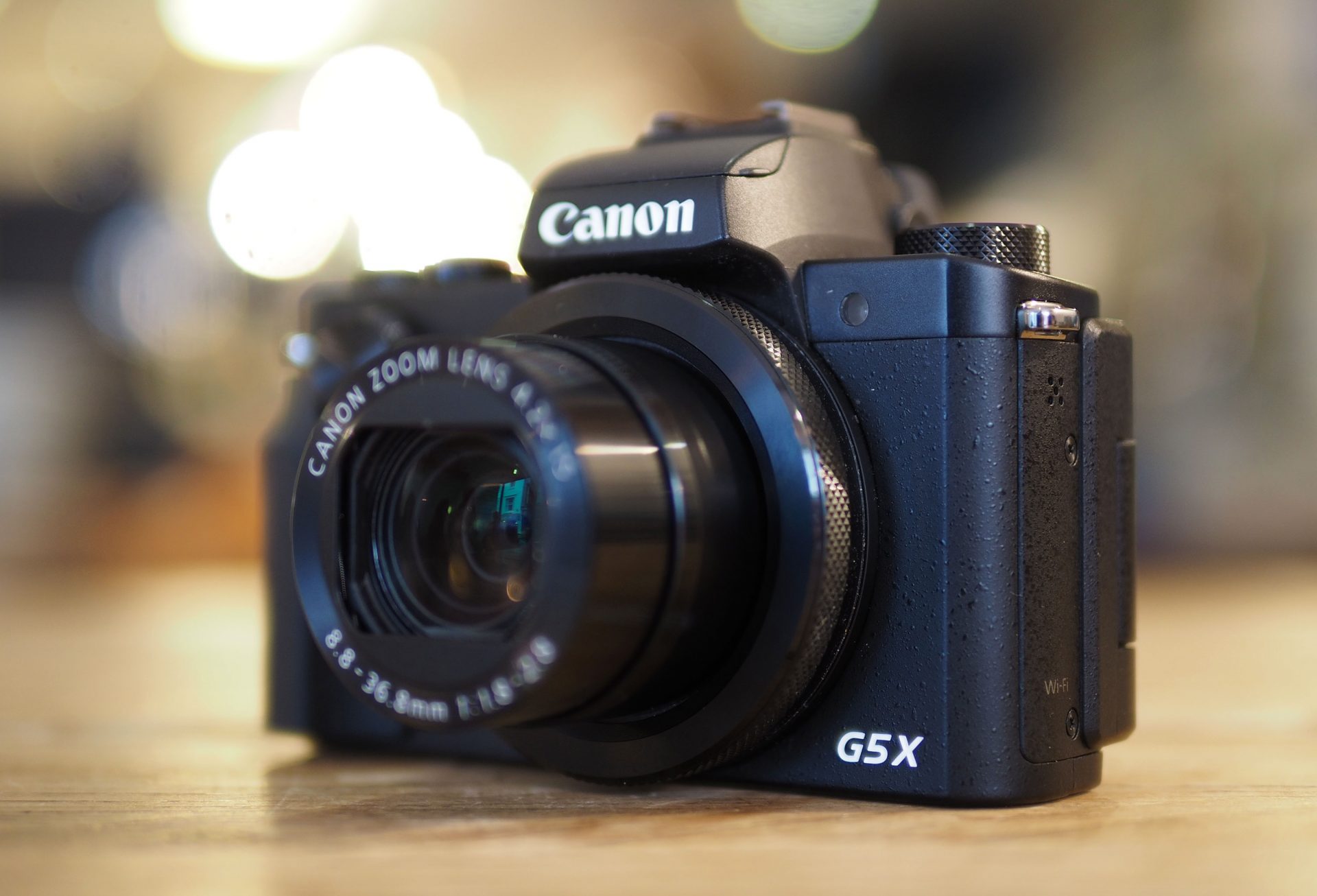
 Canon's PowerShot G5X is one of the most capable compacts around, delivering much of the experience of a larger camera in a smaller, lighter and often cheaper form factor. The really clever part is it's essentially based on the best-selling PowerShot G7X, but enhances it in a number of key respects to become a much more satisfying camera to shoot with. For me, the G5X is more of a standalone camera than one that would partner a larger system. It's a confident all-rounder I greatly enjoyed shooting with over an extended test period and one I can Highly Recommend if you're happy with the 1in quality and don't need pocket dimensions, 4k video or a longer zoom.
Canon's PowerShot G5X is one of the most capable compacts around, delivering much of the experience of a larger camera in a smaller, lighter and often cheaper form factor. The really clever part is it's essentially based on the best-selling PowerShot G7X, but enhances it in a number of key respects to become a much more satisfying camera to shoot with. For me, the G5X is more of a standalone camera than one that would partner a larger system. It's a confident all-rounder I greatly enjoyed shooting with over an extended test period and one I can Highly Recommend if you're happy with the 1in quality and don't need pocket dimensions, 4k video or a longer zoom.



